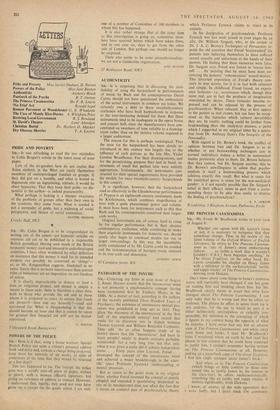AUTHENTICITY
SIR,—It is surprising that in discussing the justi- fiability of using the harpsichord in performances of music by Bach and his contemporaries David Cairns should not have questioned the authenticity of the actual instruments in common use today. We certainly owe a debt to those twentieth-century craftsmen who have built harpsichords in response to the ever-increasing demand for them. But these instruments tend to be inadequate in the opera house and concert hall, since the manufacturers have con- centrated on sweetness of tone suitable to a drawing- room rather than on the incisive volume required in a larger auditorium.
The reason for this is perhaps sociological. That the taste for the harpsichord has been slowly re- introduced in this century was largely due to the influence of such patrons as the late Mrs. Violet Gordon Woodhouse. For their drawing-rooms, and for the proselytising purpose they had in hand, in- struments of small but perfect tone were entirely appropriate. Unfortunately, the instruments con- structed for their special requirements have provided the models for most twentieth-century harpsichords in this country.
It is significant, however, that the harpsichord used so effectively in the Glyndebournc performances of Poppea is an eighteenth-century instrument, made by Kierkemann, which combines magnificence of tone with a quite phenomenal power and volume. It. must have been for instruments such as this that Bach and his contemporaries conceived their larger- scale works.
Original instruments are, of course, hard to conic by for regular performance, but in their absence contemporary craftsmen, while continuing to make their exquisite instruments for domestic use, should surely also begin to construct models for use in larger surroundings. In this way, the inaudibility justly complained of by Mr. Cairns could be avoided and the instrumentation of baroque music restored to its true scale and dimension.
45 Campden Street, W8
ANTDONY BESCI I






























 Previous page
Previous page